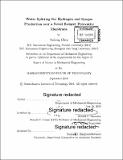Water splitting for hydrogen and syngas production over a novel bi-layer perovskite membrane
Author(s)
Chen, Yudong,S.M.Massachusetts Institute of Technology.
Download1138990832-MIT.pdf (17.57Mb)
Other Contributors
Massachusetts Institute of Technology. Department of Mechanical Engineering.
Advisor
Ahmed F. Ghoniem.
Terms of use
Metadata
Show full item recordAbstract
Increasing consumption of fossil fuel leads to challenging environmental problems. Novel technologies are required to curtail CO 2 emissions. Mixed ionic-electronic conducting (MIEC) membrane is one of the most promising technologies for CO2 mitigation due to its potential to enhance the efficiency and performance in various industrial applications. The perovskite MIEC membranes have high oxygen permeability and 100% oxygen selectivity. The goal of this study is to develop a bi-layer MIEC membrane configuration and investigate its performance for water thermochemical reduction. In this bi-layer membrane configuration, LaO.8 SrO.2 Cro9.5 Co0.05 (LSCC) is exposed to the feed side (high oxygen potential side) and LaO.8 SrO.2 CoO3 (LSCo) is chosen for the sweep side (low oxygen potential side). These two materials demonstrate different properties on the two surfaces. The bi-layer membrane configuration is thermodynamically favorable for water reduction. Meanwhile, the second layer of LSCo at the sweep side surface enhances the surface activity for oxygen dissociation. The two materials LSCC and LSCo are fabricated using glycine-nitrate process. The characterizations of the two materials have been investigated in this study. The air separation experiments are conducted over the two materials, respectively. Co-production of hydrogen and syngas from water splitting is investigated using the single layer LSCC membrane and bi-layer membrane. The analysis shows that the bi-layer membrane has 0.149 [mu]mol/cm2-s oxygen fluxes in water splitting environment. The bi-layer configuration provides more than 30% enhancement of oxygen fluxes in water splitting environment compared with the single-layer LSCC membrane.
Description
Thesis: S.M., Massachusetts Institute of Technology, Department of Mechanical Engineering, 2019 Cataloged from PDF version of thesis. Includes bibliographical references (pages 125-130).
Date issued
2019Department
Massachusetts Institute of Technology. Department of Mechanical EngineeringPublisher
Massachusetts Institute of Technology
Keywords
Mechanical Engineering.